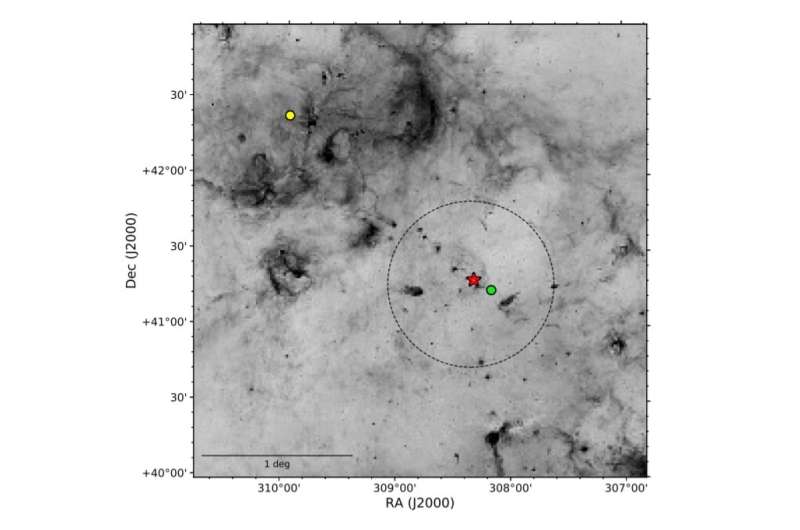The region of the CygOB2 assocation showing the location of J20395358+4222505 (yellow dot). The red star marks the position of the CygOB2 #8 multiple stellar system, which may be considered the center of the association, and the green circle represents CygOB2 #12. The dashed circle indicates the core of the association as defined by Wright et al. (2015). Credit: Herrero et al., 2022.
Astronomers from the University of La Laguna, Spain and elsewhere have performed spectroscopic observations of an early B-type supergiant star known as 2MASS J20395358+4222505. Results of this observational campaign, published February 23 on the arXiv pre-print server, deliver important insights into the nature of this object.
Supergiants are evolved high-mass stars, larger and more luminous than main-sequence stars. Studying such objects is crucial for improving our understanding of stellar evolution; however, their observation is complicated due to the fact that they are relatively far away, tend to be born in binary or multiple systems, and are associated with dense clouds of interstellar material.
2MASS J20395358+4222505 (or J20395358+4222505 for short) is a highly reddened supergiant of spectral type B0 I in the vicinity of the Cygnus OB2 association. The star is located some 5,730 light years away from the Earth and has an absolute magnitude of approximately -9.8, which makes it one of the most luminous objects among the B supergiants.
Given that J20395358+4222505 remains a poorly studied supergiant, a team of astronomers led by University of La Laguna's Artemio Herrero investigated it using the MEGARA integral-field and multi-object fiber spectrograph at the Gran Telescopio CANARIAS (GTC).
"In this paper we present new observations of J20395358+4222505 obtained with MEGARA at the 10.4m GTC telescope and a first analysis to obtain its stellar parameters," the researchers wrote in the study.
MEGARA observations found that J20395358+4222505 is about 41.2 times larger than the sun, while its spectroscopic mass is about 46.5 solar masses. The star has an effective temperature of 24,000 K and rotational velocity of some 110 km/s.
The astronomers identified a particularly strong hydrogen-alpha emission in J20395358+4222505. The star showcases a mild underabundance of carbon, but in general its chemical composition turns out to be similar to that of our sun. All in all, the abundance analysis allowed the team to conclude that J20395358+4222505 has a spectral type B1 Ia.
The researchers assume that J20395358+4222505 is in an intermediate phase between super- and hypergiant and will join the group of B hypergiants in the near future. They also suppose that this star was initially a part of a binary system due to its relatively high rotational velocity, high mass-loss rate and chemical abundance.
"Together with the nearly solar CNO [carbon–nitrogen–oxygen] abundance pattern, they may also point to evolution in a binary system, J20395358+4222505 being the initial secondary," the authors noted.
However, further observations of J20395358+4222505 are required in order to find stronger evidence indicating the presence of a former more massive companion.
More information: The nature of the Cygnus extreme B-supergiant 2MASS J20395358+4222505, arXiv:2202.11806 [astro-ph.SR] arxiv.org/abs/2202.11806
© 2022 Science X Network
























